Follow this simple recipe and video tutorial for the best all butter pie crust. It will make you a pie expert immediately! Complete with all my tips and troubleshooting, this pie crust recipe is buttery, flaky, and tender with the most incredible flavor.
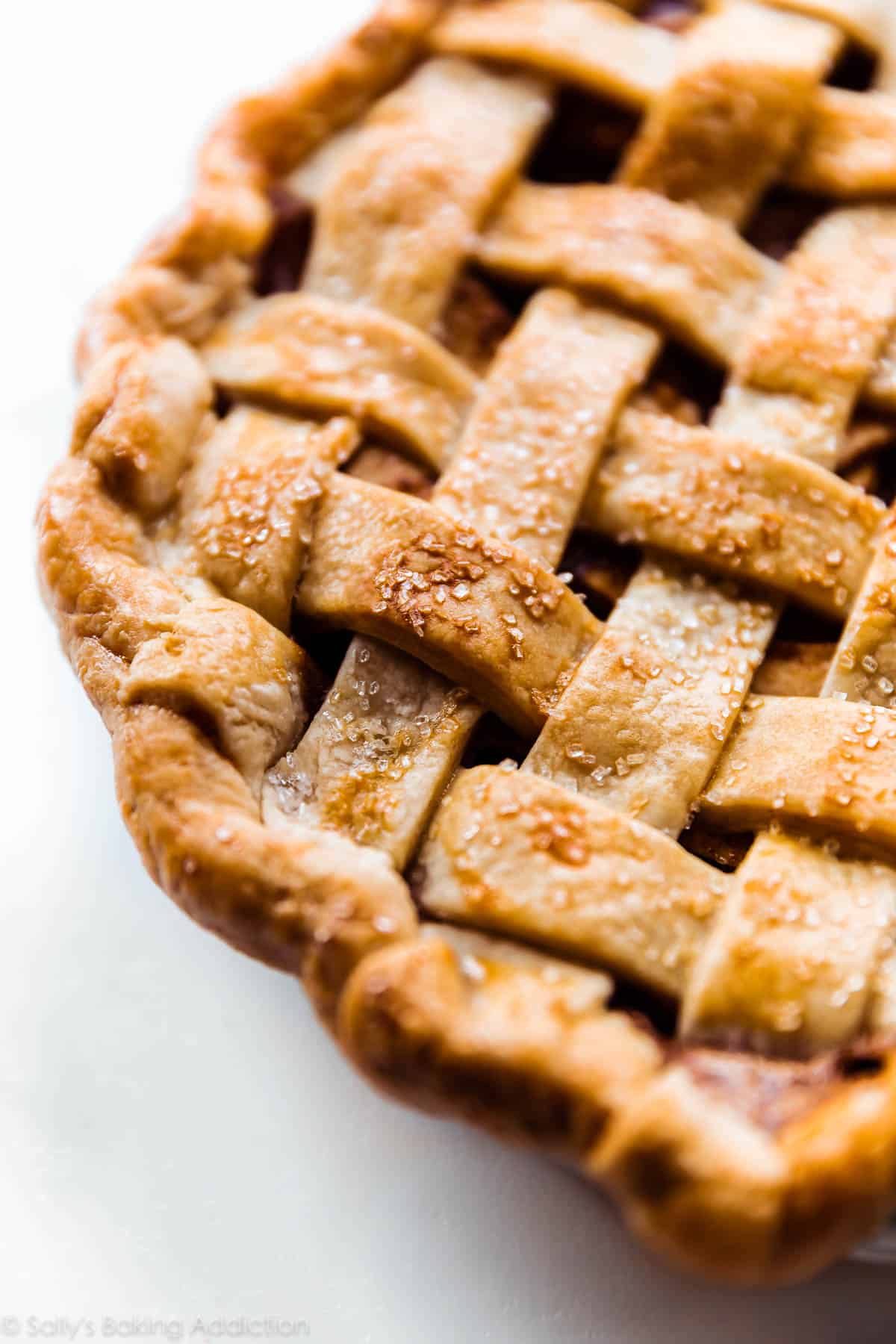
At the request of many, today I’m sharing my go-to all butter pie crust recipe. It competes with my butter and shortening pie crust for the #1 spot in my pie-loving heart. (Scroll to the recipe notes for my pie crust comparison!) I’ve made thousands of pies in my day and consider myself a pie expert. A pi-expert, if you will. I’ve made all the pie crust mistakes so I can coach you through the process and supply you with all the knowledge and confidence to tackle pie crust once and for all.
You’ll be a pi-expert with this recipe and tutorial on your side!
Watch my video tutorial for butter pie crust with lattice topping. This is my homemade apple pie with chai spices, a favorite every Fall season.
Start with a dependable pie crust recipe and you’re set for success. Soon everyone will be asking YOU for all your pie crust secrets.
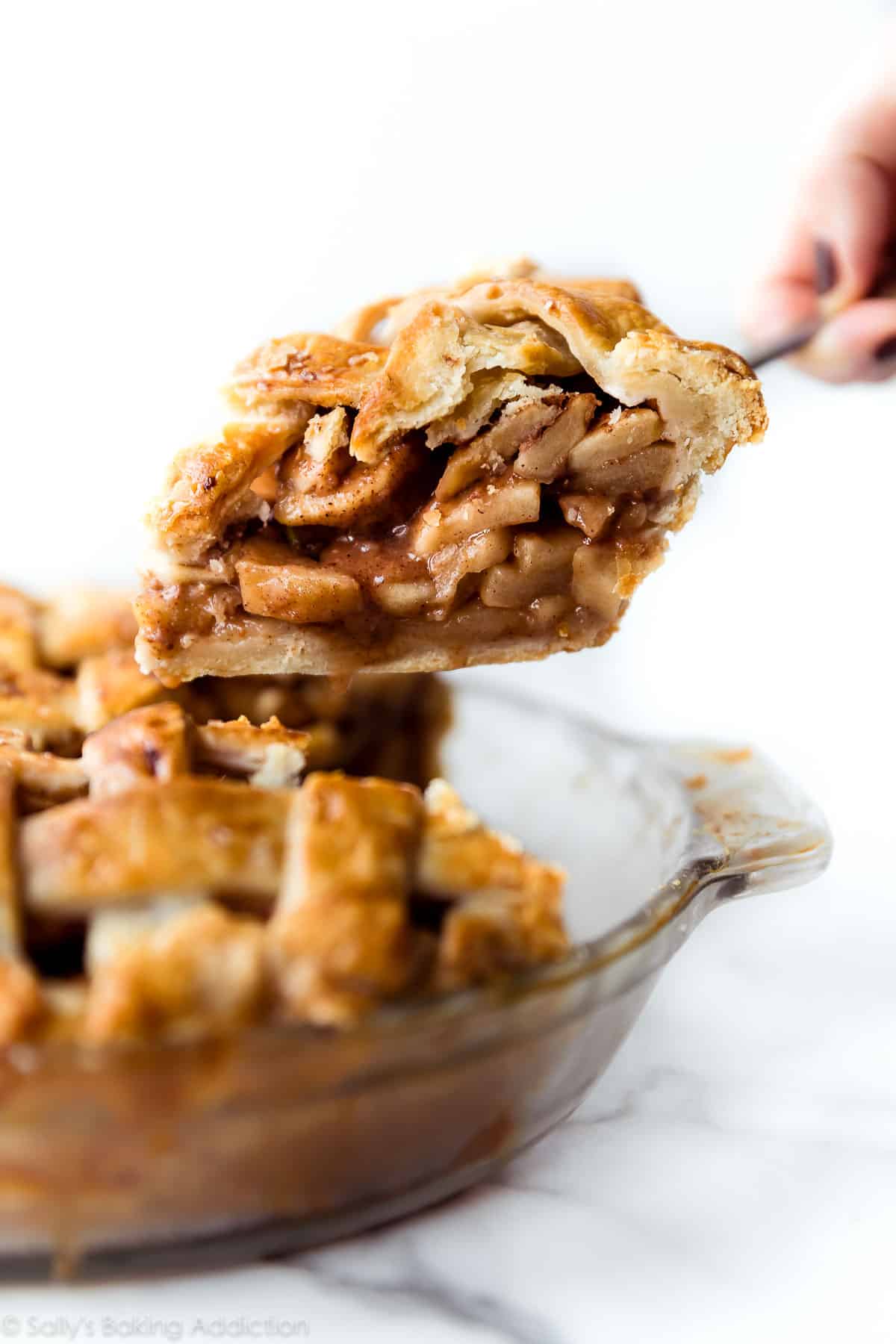
Only 5 Ingredients in Butter Pie Crust
This pie crust is made with 5 ingredients. Each ingredient has a very specific job. And with so few ingredients, it’s important to use the best quality.
- Flour – The structure of pie crust.
- Salt – Flavor flavor flavor. Use table salt instead of coarse salt. Smaller salt crystals dissolve and disperse more evenly throughout the dough.
- Granulated Sugar – Pie crust should not be sweet, but adding a little sugar to butter pie crust improves its flavor and enhances browning. The sugar crystals also help break down the hard pieces of butter.
- Cold unsalted butter – Supplies the pie crust’s unbeatable flavor and flaky texture. Use unsalted butter. The amount of salt in different brands’ salted butter varies, so for better control over the flavor, it’s best to begin with unsalted and add your salt.
- Ice water – The final ingredient, about 1/2 cup of ice cold water holds all the ingredients together. Use just enough so the dough holds its shape when rolling out. Many pie crust recipes don’t call for enough ice water, giving you a dry pie dough that cracks when you roll it out. When in doubt, add a little more water. You’re better off with more water (wet pie dough) than not enough water (dry, cracking pie dough) because you can always work more flour into the dough, but you can’t really add water to the pie dough when you’re trying to roll it out.
I use this crust in my apple cheddar pie—there I add some sharp cheddar cheese. It’s also the starting point for chocolate pie crust that we use for chocolate pop tarts!
Basic Pie Crust Steps
- Mix dry ingredients together.
- Cut in the butter with a pastry cutter or food processor.
- Add ice water a little bit at a time until the dough begins to come together. It will feel thick and moist, not overly wet. You’ll use around 1/2 cup (120ml).
- Mold pie dough into a ball.
- Cut in half. This recipe yields two 9-inch pie crusts.
- Flatten into discs. Wrap in plastic wrap.
- Chill for 2 hours before using.
These steps are shown in the video tutorial above and described in the recipe below.
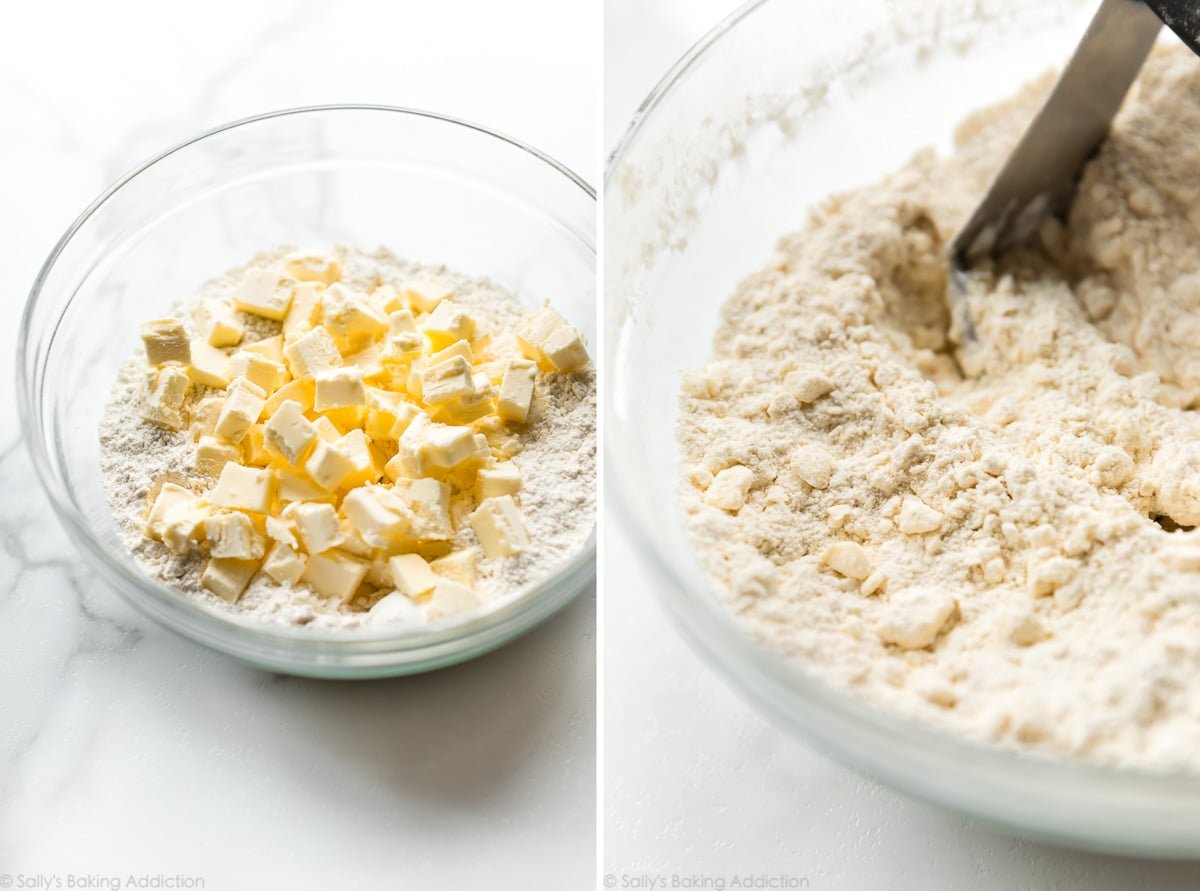
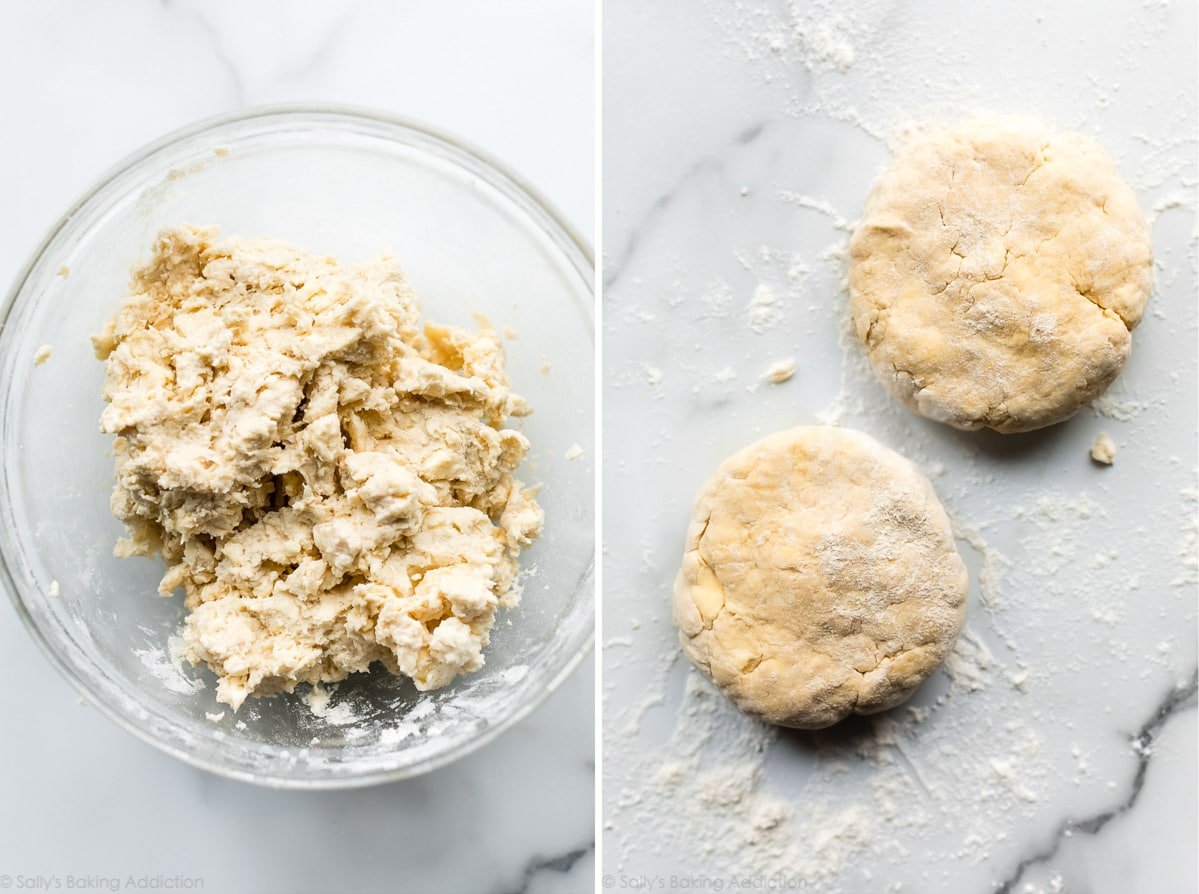
Why the Emphasis on Cold?
Keeping your pie dough as cold as possible prevents the fat from melting too soon. Too soon = before the pie crust enters the oven.
- What happens when the pie dough is warm? The butter in the pie crust will melt before baking, which means you lose all the flakiness and structure. Warm pie dough melts into a pool of grease. You’ll have a hard, crunchy, and greasy crust instead of a beautifully tender flaky crust.
- What happens when the pie dough is cold? The butter in the pie crust will melt inside the oven. Butter has a high volume of water content and this water converts to steam as the pie dough bakes. The steam separates the crust into multiple flaky layers, making this the most delicious pie crust ever.
The colder the dough, the flakier the pie crust.
How to Keep Pie Dough Cold:
- Use ice cold water. Fill a glass with 1 cup of water, add ice. You only need 1/2 cup of water in this butter pie crust recipe, but have a little extra just in case.
- Use cold butter. I keep some of my butter in the freezer and transfer it to the refrigerator a couple hours before beginning the crust. The butter is part frozen and very cold.
- Chill the pie dough for at least 2 hours before rolling out. This step is non-negotiable; it’s the most crucial in the entire pie crust recipe.
- For extra insurance, chill your flour and your mixing bowl in the refrigerator or freezer. Sounds a little silly, but trust me… it really helps!
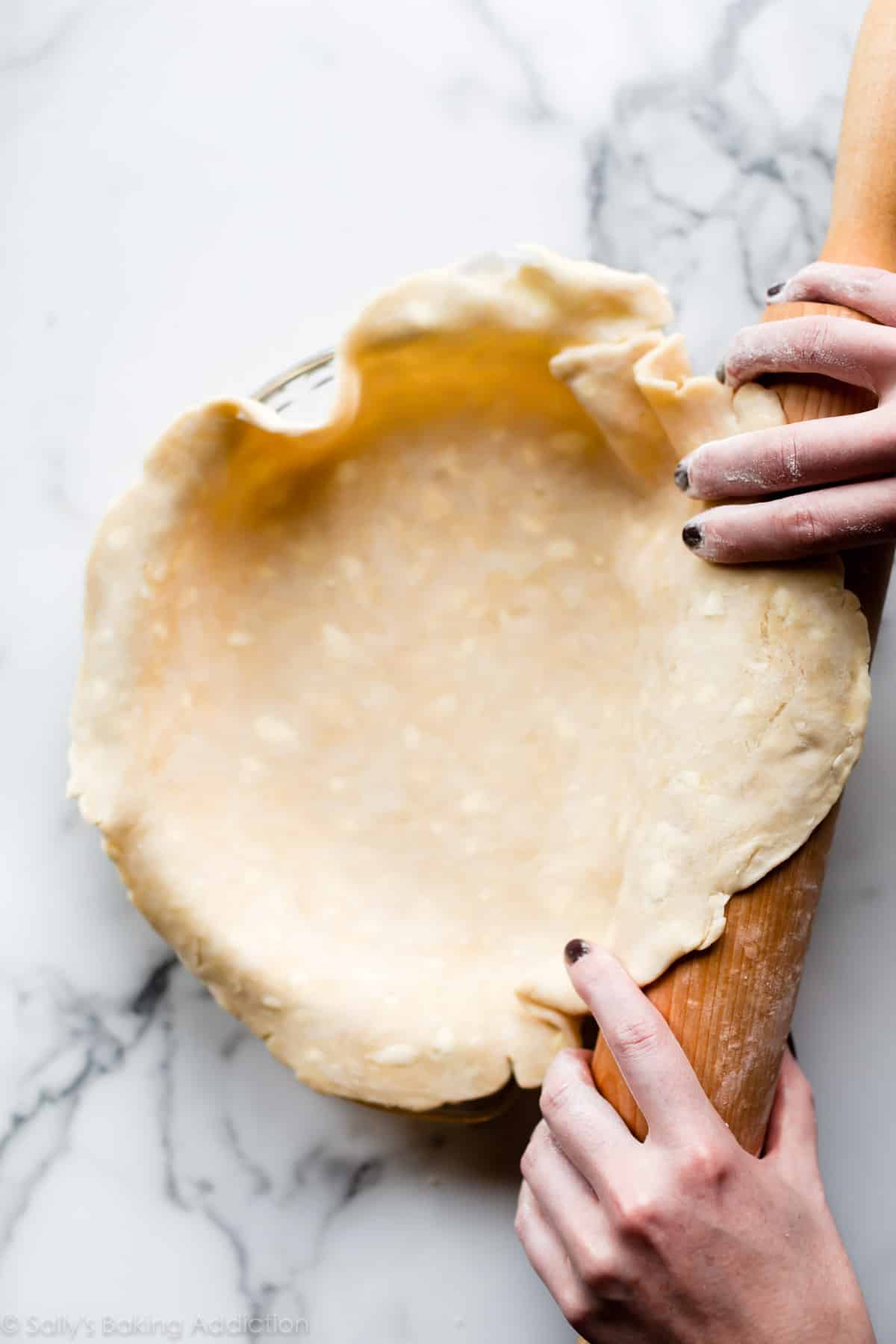
How to Roll Out Pie Dough
After the dough has chilled, it’s time to roll it out. Keep a small bowl of flour nearby to keep your work surface, rolling pin, and hands lightly floured. This prevents the pie dough from sticking. When rolling pie dough out, always start from the center and work your way out in all directions, turning the dough as you go. If the pie dough feels too warm or the butter is melting, stop. Lift it up, place on a baking sheet, and chill in the refrigerator for at least 10 minutes before continuing.
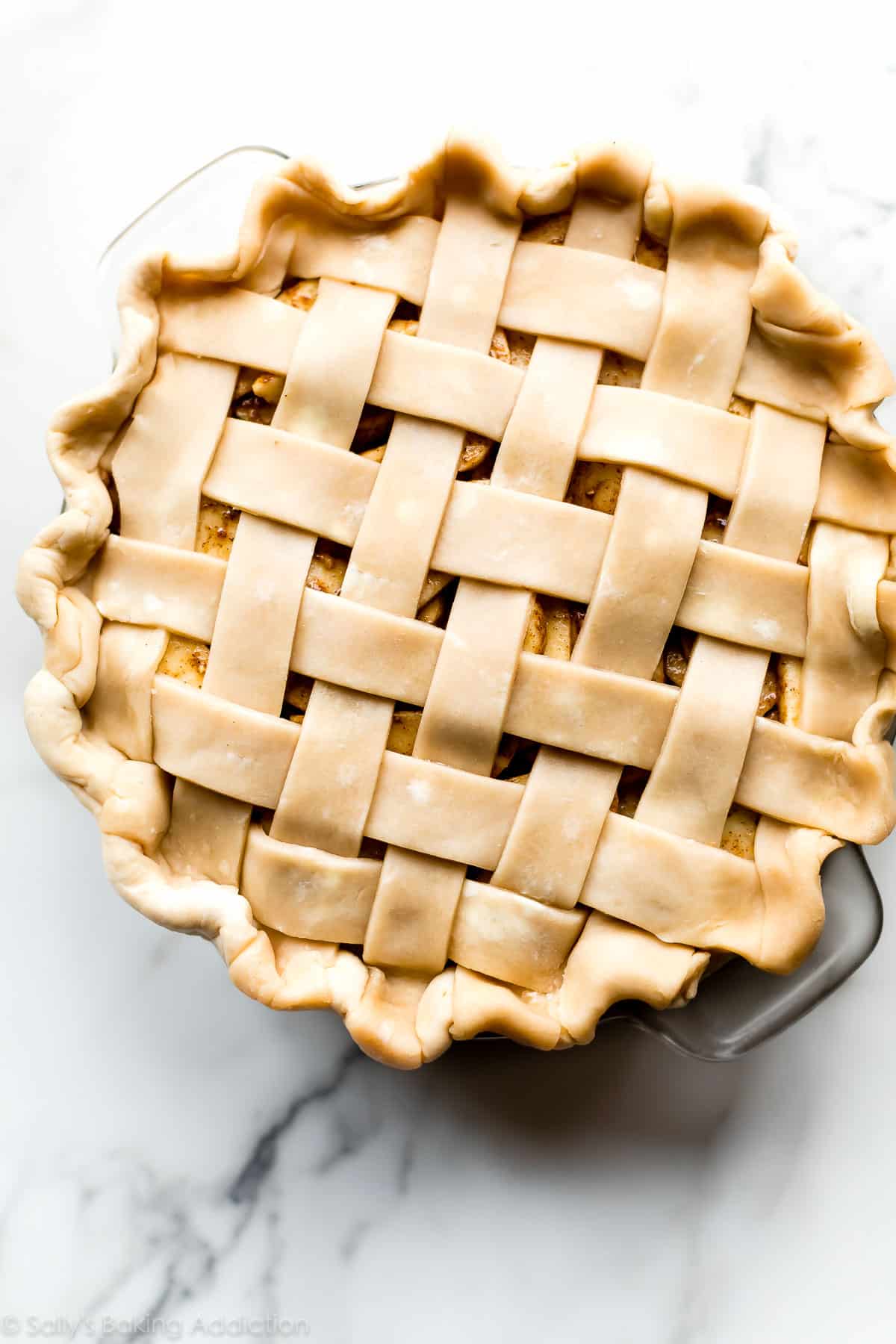
Butter Pie Crust Tips
- I’m going to repeat myself here. Keep all pie crust ingredients cold. On a hot day, you can chill the measured out flour in the refrigerator or freezer before starting. When taking the pie crust out of the refrigerator to roll out and fill, make sure your pie filling is ready to go. If not, keep the pie crust in the refrigerator until it is.
- Glass pie dishes are best. Why? As opposed to ceramic or metal pie dishes, glass pie dishes conduct heat evenly, which allows the bottom of the crust to bake thoroughly. Also, you can see when the sides and bottom of the crust have browned.
- If your pie recipe requires pre-baking (blind bake pie crust)—let’s say you’re making a pie with an especially wet filling—use pie weights or dried beans. Without pie weights, the pie dough will puff up, then shrink. Whichever you choose, be sure to line the crust with parchment or aluminum foil, then fill the empty pie crust with the weights. See my post and video tutorial for how to blind bake pie crust.
- Always use a pie crust shield. A shield keeps the crust edge covered, which protects it from browning too quickly or worse, burning. Use an adjustable silicone pie crust shield that you can fit to the size of your delicate pie crust. Metal can break the crust. Alternatively, you can cover the pie with a piece of aluminum foil. Cut a large circle in the center of the square so the center of the pie is exposed.
- Learn how to braid pie crust with my how to braid pie crust video tutorial.
- Learn how to lattice pie crust, too.
- Last but not least, learn how to crimp and flute pie crust. Those pretty decorative pie crust edges add function and flair!
Pie Crust Troubleshooting
- Prevent a crumbly pie dough that rips and tears when you roll it out. Make sure you use enough ice water when preparing your pie dough. Too little water creates an unworkable dough.
- Prevent a tough pie crust. Tough crusts are the result of not enough fat in the crust, as well as overworking the dough. Use the all butter pie crust recipe or my shortening and butter pie crust recipe to ensure a flaky, tender pie crust. Additionally, don’t work the dough too much.
- Prevent a burnt crust with a pie shield. See above.
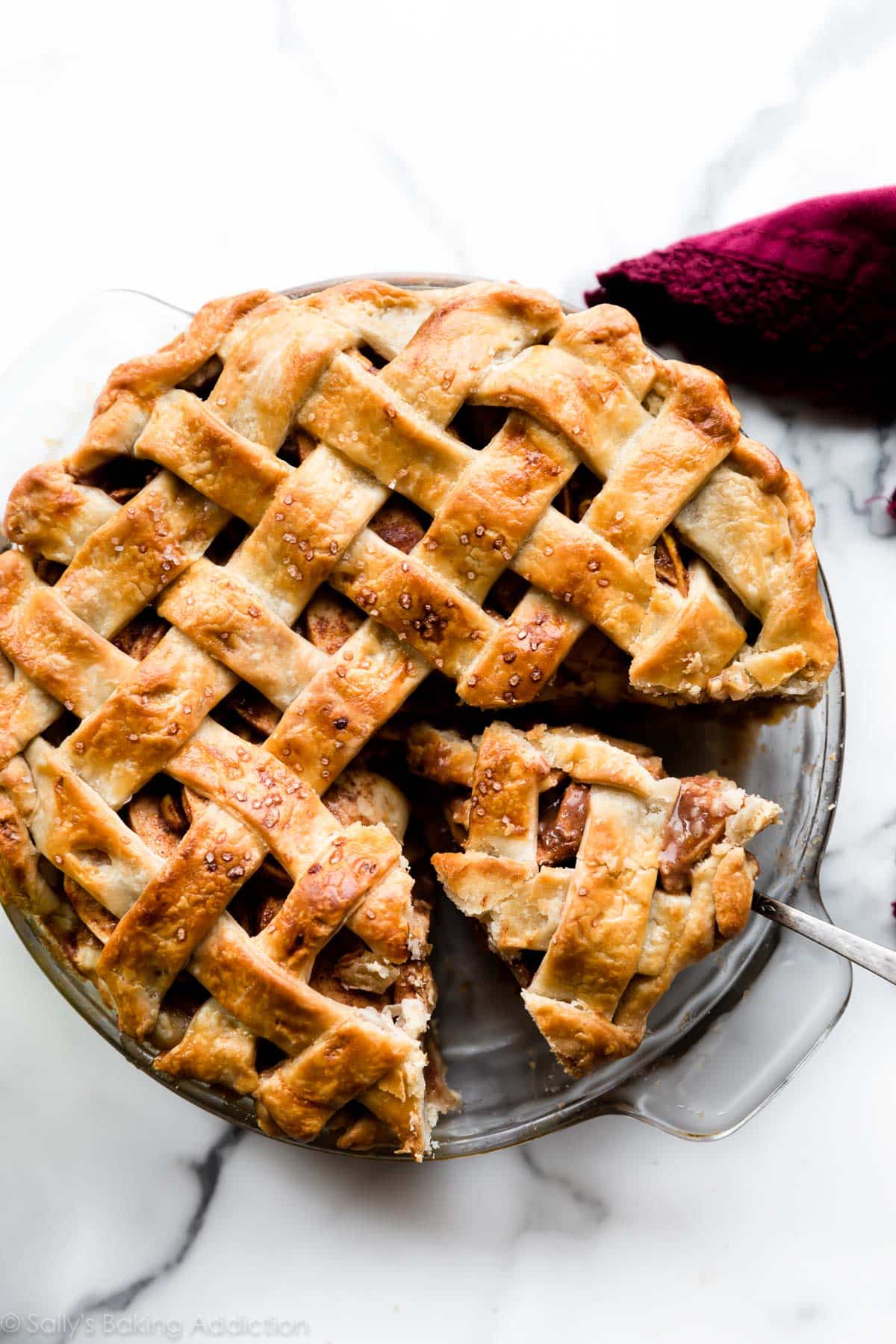
Recommended Pie Crust Tools
(All my recommend products are affiliate links. I trust these tried-and-true tools!)
- Pastry cutter – Though you can use a food processor to make this butter pie crust, I strongly recommend a pastry cutter to avoid over-mixing. Food processors are quick to over-work pie dough.
- Pastry mat – I prefer rolling pie dough out on a lightly floured counter because countertops are usually colder, but you can use a lightly floured pastry mat instead.
- Rolling pin – An obvious must with pie dough! I also love this marble rolling pin. Marble rolling pins are usually cooler to touch and we all know that pie dough loves the cold.
- Glass pie dish – My mother-in-law bought me this Pyrex pie dish 5 years ago and it’s been my go-to ever since. I have 4 of them now! Like I mention in my pie crust tips above, glass pie dishes conduct heat evenly, which allows the bottom of the crust to bake thoroughly. This is important. There’s no comparison, Pyrex is the best.
- Pizza cutter or pastry wheel – To cut your pie dough into strips for lattice decoration or any decoration. Have you seen my pie crust designs post?
- Pastry brush – An egg wash is simply an egg mixed with milk or water (usually milk). Lightly brush the pie dough with an egg wash using a pastry brush. The egg wash creates a golden, shiny, crisp crust. Without it, pie crust is dull and lacking color.
- Pie weights – These are crucial when you blind bake pie crust for no-bake or custard pies. Note: 2 packs of these pie weights is definitely needed!
- Pie crust shield – Pie crust edges are usually higher up than the center of the pie, leaving them exposed to the most heat. They brown quicker than the center of the pie, so it’s important to protect it with a shield. I usually place a pie crust shield on the pie about halfway through bake time. I recommend an adjustable silicone pie crust shield that you can adjust. Or you can cover the pie with a piece of aluminum foil: cut a circle in the center so the center of the pie is exposed.
Pie Recipes
Now that you’re fully prepared and equipped, here are several pie recipes to use your all butter pie crust. Pictured is my chai spice apple pie and I topped it with salted caramel in the video.
- Traditional Apple Pie & Salted Caramel Apple Pie
- Lemon Meringue Pie (a blind bake pie crust recipe)
- Caramel Pear Pie
- Pumpkin Pie
- Pecan Pie
- Banana Cream Pie (a blind bake pie crust recipe)
- Cherry Pie
- Peach Pie
- Blueberry Pie
- Sweet Potato Pie
- Fun recipes: Apple Hand Pies, Brown Sugar Cinnamon Pop Tarts, Pecan Pie Tarts
- Or any of my favorite Thanksgiving pie recipes!

All Butter Pie Crust
- Prep Time: 20 minutes
- Cook Time: 0 minutes
- Total Time: 2 hours, 20 minutes
- Yield: 2 pie crusts
- Category: Pie
- Method: Baking
- Cuisine: American
Description
Follow this simple recipe and video tutorial for the best all butter pie crust. It will make you a pie expert immediately! Complete with all my tips and troubleshooting, this pie crust recipe is buttery, flaky, and tender with the most incredible flavor.
Ingredients
- 2 and 1/2 cups (313g) all-purpose flour, plus more as needed (spooned & leveled)
- 2 teaspoons granulated sugar
- 1 teaspoon salt
- 1 cup (16 Tbsp; 226g) unsalted butter, chilled and cubed
- 1/2 cup (120ml) ice water, plus more as needed
Instructions
- Mix the flour, sugar, and salt together in a large bowl. Add the cubed butter on top.
- Using a pastry cutter, food processor, or two forks (pastry cutter is ideal, see post above), cut the butter into the dry ingredients until all flour is coated. You’re looking for pea-sized bits of flour coated butter. A few larger bits of butter is OK.
- Measure 1/2 cup (120ml) of water in a cup. Add ice. Stir it around. From that, measure 1/2 cup (120ml) of water since the ice has melted a bit. Drizzle the cold water in, 2 Tablespoons (30ml) at a time, and stir after each addition. Stop adding water when the dough comes together easily and begins to form large clumps. The dough will feel moist and a little sticky, but not feel overly wet. Do not add any more water than you need to. I always use about 1/2 cup (120ml) of ice water.
- Place pie dough on a lightly floured work surface. Using floured hands, fold the dough into itself until the flour is fully incorporated into the fats. Form it into a ball. Divide dough in half. Using your hands, flatten each half into a 1-inch thick disc.
- Wrap each disc tightly in plastic wrap and refrigerate for at least 2 hours and up to 5 days before using in a pie recipe.
- When rolling out the chilled pie dough discs, use gentle force with your rolling pin. Start from the center of the disc and work your way out in all directions, turning the dough with your hands between rolls. Smooth out the edges if you notice cracks. (See video above.) Keeping your work surface, rolling pin, and hands lightly floured makes rolling out easier.
- Proceed with the pie per your recipe’s instructions.
Notes
- Make Ahead Instructions: Prepare the pie dough through step 4 and freeze the discs for up to 3 months. Thaw overnight in the refrigerator before using in your pie recipe.
- Special Tools (affiliate links): Glass Mixing Bowl | Pastry Cutter | Silicone Spatula | Rolling Pin | 9-inch Glass Pie Dish | Pizza Cutter or Pastry Wheel | Pastry Brush | Pie Weights | Pie Crust Shield
- Pie Crust Comparison: Let’s see how this all butter pie crust recipe compares to my favorite buttery flaky pie crust, which uses a mix of shortening and butter. Due to butter’s high water content, this all butter pie crust is lighter textured with more defined flakes. As the crust bakes, the butter’s water converts to steam, creating thousands of deliciously light flakes. It’s also so buttery! However, because of all this butter, I find that the shortening and butter pie crust is a little easier to work with. Shortening has a higher melting point than butter, so the crust holds its shape wonderfully. Both crusts are fantastic, but if you are looking to make intricate pie crust designs I highly recommend my buttery flaky pie crust.
- Try This: Replacing 1 Tablespoon of ice water with cold apple cider vinegar creates an even flakier, more tender pie dough. It’s so tasty. Try it!



















Hi Sally,
Can I put the pie crust in the freezer for an hour instead of the fridge to speed up the cooling process?
I don’t recommend it. It always chills unevenly and rolling out (and shrinking while baking!) is always an issue.
Came out absolutely perfect! I actually made a pot pie with it! So yummy! I printed this to now have as my go to crust! Thank you!
Wunderbar! Delicioso! Delicious! I use this crust for all this needing a crust and get rave reviews every single time, so I thought a 3 language salute would suffice for praise.
Hi Sally,
Thanks for all the good tips! I tried to keep my pie dough colder and it definitely helped. My one question is that you recommend to put the pie dough in the fridge for at least 2 hours before rolling the dough out. When I do this, all the moisture gets sucked out of my dough and it become really dry and hard. Any advice? What’s happening?
Hi Sarah, Be sure that you are covering your dough very well (I use plastic wrap to be sure it’s airtight) when storing it in the fridge!
I just started baking and made this recipe yesterday and I’m pretty sure I over worked the crust (got too excited haha) and it won’t come out the way it should once baked. HOWEVER, I learned everything I shouldn’t do and why certain things are so important! I thank you Sally for all your wonderful recipes, excellent advice, and for egging us beginners on. You are contributing to wonderful memories I’m making with my kids, nieces, and nephews. ❤
The pie recipe I’m using calls for using an unbaked pie shell. Would I just bake according to that recipe without pre-baking this crust?
Yes, that is correct!
Can this pie crust be used for savory pot pies?
Absolutely! It’s not a sweet pie crust.
Hooray for this recipe and it’s close to the one I use but I’m going to make yours next time. I’m really enjoying your website because I’m a pretty good cook but baking is a challenge for me although I LOVE TO BAKE!!! Thanks so much for your great instructions and I”m glad you have the passion and you are sharing!!!
Tried this pie crust for a blueberry pie for thanksgiving and everyone said it was delicious, but the crust was amazing! This will definitely be my go to for pies, Thank you for this recipe!
Lest year this time I made this pie crust and was delighted with the texture and how easy it was to work with etc… but this year I made it and I have reached perfection. I volunteer to make the pies for our big family every year and have probably made about 100 pies over the years, this recipe is now my secret weapon.
Thanks!!
When I make this, then I back the pie crust, the crust shrinks and slips down inside the pie pan.
Hi, Sally – I am a 72 yr old gramma who has tried countless pie crust recipes in my baking history from oil to vinegar to lard and never did I have the beautiful crust that I did with this recipe!! I followed your recipe and directions to the letter. I used my food processor and not quite the 1/2 cup of ice water. I made 2 discs and refrigerated over night. Made 8 beautiful hand apple pies and a gorgeous 9″ pumpkin pie this morning – everything from scratch. So easy to roll and work with. I will throw away the many recipes I have gathered over the years – yours is my new ‘go to’. Thank you!!!! P.S. I am a huge fan of yours – I have cooked countless recipes from your site and they have all been superb!
Hi Sally, first time making a pie crust, so I am sure it’s my fault, but my crust really stuck to the glass pie plate. Also, it was rock hard when I took out of fridge. Even after leaving out for 30 min it was very hard to roll out, it was nothing like your video. It tasted good, but not flaky at all. I am an avid fan of your recipes, and I want to try again. Pointers to correct my “fails”?
Hi Ileana! I’m happy to help. I recommend making sure that the butter is cut into the flour mixture as well as possible– you want very small and uniform pieces of butter. No large chunks hiding in there! After forming into discs and refrigerating, if the dough is too hard, let it rest at room temperature until it’s pliable for rolling out. Even if that takes longer than 30 minutes. Make sure you are using enough ice water, too. I always use 1/2 cup.
Can you make this using salted butter?
Hi Kathy! If using salted butter, reduce the amount of added salt to 1/2 teaspoon.
Hi Sally,
I’m planning on using this recipe for homemade pumpkin pie. I have a couple of questions. Can this be made using a stand mixer? Should this be blind baked for a pumpkin pie?
Hi Cristina! Only blind bake the pie crust if a recipe calls for it. If using my pumpkin pie recipe, I instruct you how to blind bake it for that particular pie. I do not recommend a mixer for preparing pie dough.
Sally, what do you think of using a food processor for this recipe?
Hi Diana! That’s completely fine, but I always prefer and encourage a pastry cutter. Food processors can quickly over-work pie dough.
Awesome recipe but I do not see a video. Is there a link?
Hi Sally,
I’m trying to make the pie dough now but I have a question….when you take it out of the bowl to form a ball and cut it up, should it still be crumbly? Cause my was and I now divided it and it’s in the fridge, but didn’t know for sure
Thanks!
Lisa
Yes, it will be a little crumbly– you can see that in the video, too! Hope this helps.
Hi Sally! I tried this pie dough recipe a while back and it was absolutely amazing! I tried it again a few weeks ago and had some trouble. The first time I believe I used my hands to mix the dough after adding the cold water.
This time, I tried using a fork because I thought that it would mix the dough without warming the dough like my hands would. It didn’t exactly mix the dough so I panicked and used my hands and I ended up with a gluten filled stretchy dough that turned hard and tough after baking, my guess is that I over worked it. Unless I missed it, I didn’t see anything that said what you used to stir your dough, not even in the video on this page. Like I said before, I think I used my hands to mix it the first time and it was a beautiful crust but I’m not sure if it’s the best way. What is the best utensil for stirring your dough without over working/warming it? Thanks!
Hi Shawni! Your hands are the most powerful tool in pie making, so use them if you’d like. Though there’s no mixing after all the water is added. You just form into a ball, cut in half, then flatten into discs. If you’re referring to how to mix the dough as you add the water, I use a rubber spatula– you can see that in the video, too!
Ok, I must’ve watched the wrong video, thanks so much for the help!
Hi Sally, I’ve made this a few times now and I love the flavor, but the crust always flops down from the edge of the pie plate. I guess it’s shrinking. Maybe I need to press it in more? Or the fluting is too thick. Any suggestions? Thank you! Heidi.
Hi Heidi, This is usually a result of overworking the pie dough. Pie dough should only be mixed until the ingredients come together. Let it rest for at least 2 hours in the fridge– and if you can let it rest longer, awesome. Better yet, make the pie dough discs a few days in advance so they can rest during that time. Likewise, use gentle force when rolling out pie dough. Roll out very slowly and take your time. Keep the ingredients as cold as possible. You can even freeze the crust for 20 minutes before baking. That always always helps!
Thank you Sally, I will try these tips next time. Much appreciated!
I’ve already made this pie crust several times and each time it has turned out to be ah. may. zing. I usually make a lattice design on top and the pie dough is very easy to work with…stunning designs (and, of course, the beautiful buttery, flaky layers) with no crazy amount of effort 🙂
I did a little experiment and made this crust with white whole wheat four… I was a little nervous but it actually came out really good! Still really flakey and yummy. I just needed a little extra water.
Happy Thanksgiving Sally! I followed your recipe and it was the easiest pie crust I’ve ever rolled out! However, I had it perfectly crimped and then after blind-baking before filling, it shrunk, slumped and didn’t hold its shape! What was my error?! Thanks!
Hi Mercedes! No error at all. I find that all butter pie crusts don’t hold their shape nearly as well as pie crusts made with shortening or a shortening/butter blend. Sometimes I FREEZE the butter pie crust before blind baking– holds its shape much better that way.
I just used this recipe to make your double crust chicken pot pie and it was very tender yet easy to work. I had enough and then some for my deep dish 10inch pie dish. Thank you Sally for all your hard work .
LOVE LOVE LOVE this crust recipe! I use it for pies as well as quiche. I used to make one that was half butter and half Crisco. Since I cannot get Crisco and no longer have my food processor, I make this all butter by hand and it is super yummy. Thanks for such a versatile recipe!
How do you prevent the bottom pie crust from being soggy even though it is fully baked? Thank you!
Hi Kelly! If this is a common problem, I recommend blind baking the pie crust for at least 10 minutes before adding the filling and baking. Also, if the pie filling is extra wet– the bottom crust will be soggy no matter what. Make sure you’re leaving some of the excess liquid from a pie filling in the bowl and not spooning it all into the crust. https://sallysbakingaddiction.com/how-to-blind-bake-pie-crust/
Hi Mollie! You don’t typically have to blind bake the pie crust when making chocolate chess pie. You certainly could for 10ish minutes, but it’s not necessary.
Hi Anne! This is usually a result of overworking the pie dough. Pie dough should only be mixed until the ingredients come together. Don’t use a food processor if you continue to experience pie dough shrinking. Use a pastry cutter. Let it rest for at least 2 hours in the fridge– and if you can let it rest longer, awesome. Better yet, make the pie dough discs a few days in advance so they can rest during that time. Likewise, use gentle force when rolling out pie dough. Roll out very slowly and take your time. Keep the ingredients as cold as possible. You can even freeze the crust for 20 minutes before baking. That always always helps!
Hi Jodi! That could mean that the butter and shortening were not cold enough. They began to soften, which created a wet pie dough before you were finished adding enough water. Sometimes I cut the butter and shortening in, then I freeze the mixture for 1 hour before adding the ice water. Takes extra time, but always guarantees a strong crust.
Hi Meg! I suggest my shortening and butter pie crust because the small pie crusts are more likely to hold their beautiful shape. Keep them cold. Here is my apple hand pies recipe with extra tips for making hand pies!
Hi Kathleen, you can certainly leave the pie at room temperature for a bit before serving if you like the crust better that way! I’m unsure of which cream pie recipe you are referring to but it’s 100% personal preference to use this all butter crust or the crust with shortening!
Hi Sally, my first time making pie crust from scratch and I made your pumpkin pie. Thanks for the great tutorial. The flavours were great. Everyone loved it. My only trouble is my pie crust shrank a lot during blind baking. After I shaped the dough in the pie dish, I chilled it in the fridge for 15 mins and baked it straight from the fridge. Any advice to prevent shrinkage? Thanks.